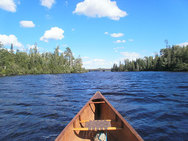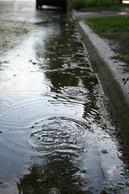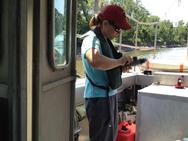 Five years ago this month, Minnesota voters passed a constitutional amendment that increased the state’s sales tax by three-eighths of 1 percent to fund projects related to clean water, natural resources, and arts and culture.
According to a 2008 poll by Minnesota Environmental Partnership, clean water was the leading issue that motivated voters to support the amendment: 42 percent of those who voted for the amendment indicated that cleaning up and protecting Minnesota’s lakes, rivers, and streams was the primary reason for their vote.
Accordingly, one-third of the funds generated through this amendment are dedicated to clean water in Minnesota’s lakes, rivers, streams, and groundwater. This stable source of funding, set in the state’s constitution for 25 years, has enabled policymakers to tackle ambitious projects that are expected to profoundly improve water quality in the state.
"Knowing that that these funds will be available for the next 20 years has changed so much about our ability to restore and protect water,” says Commissioner John Linc Stine of the Minnesota Pollution Control Agency (MPCA). “Minnesota’s water pollution problems developed over the course of many decades. We want to solve them the right way—sustainably—and the Legacy Amendment is making that possible. We’ve set an ambitious course, and thanks to this steady source of funding, we know that those goals are reachable.”
So far, more than 300 individual amendment-funded projects have been sponsored by the MPCA across the state. Though many of these efforts are still underway, the amendment is beginning to bear fruit in the form of major initiatives that will position Minnesota as a leader in water resources protection.
|
 Twenty years ago, concerned homeowners on the White Iron Chain of Lakes area near Ely made a ground-breaking decision: They committed to protecting their lakes so the gateway to the Boundary Waters Canoe Area Wilderness would remain clear and clean forever.
The homeowners were alarmed by subtle, and not-so-subtle, changes to their beloved lake region. More land was being cleared, more roads paved, more obvious water quality problems were surfacing, and perhaps most surprisingly, invasive species were already calling the area home. Immediate action was needed. The residents knew exactly what to do before things deteriorated beyond repair.
Creating a productive partnership
Their first step was to create White Iron Chain of Lakes Association (WICOLA). Next, they began a collaborative partnership with the MPCA. MPCA scientists and water quality experts taught the ardent volunteers how to use Secchi disks to monitor water clarity, take water samples, and monitor for the very problems they were hoping to avoid in the future.
In 2010, stewardship efforts and a $225,000 Clean Water, Land, and Legacy Amendment grant – the first-ever Legacy grant awarded for protection and enhancements – allowed WICOLA to hire a professional manager, conduct a comprehensive overview of water quality in developed and undeveloped areas, identify additional areas for monitoring, train more water monitoring volunteers, and expand their research and monitoring efforts.
Later that year, WICOLA’s efforts, goals, and intentions became the Kawishiwi Watershed Protection Project. They created an ambitious, multi-year joint plan to partner with the MPCA, St. Louis and Lake Counties to maintain or improve water quality within the 1,353 square mile Kawishiwi watershed.
Making progress
The project’s goals included collecting baseline water quality data and creating a comprehensive management plan. The plan would document their efforts, assess previously untested lakes and streams, develop a list of waters requiring protection, identify human impacts affecting water quality, combat aquatic invasive species, develop geographic information system (GIS) maps for suitable/unsuitable development, create a searchable public database of their findings, and conduct additional outreach and stewardship education efforts.
The project’s raw data became available in mid-2013; it will lay the foundation for, and give a head start to, the state’s 2014 Kawishiwi’s 10-year Watershed Restoration and Protection Strategies process. The volunteers’ other findings, including erosion issues at camp sites and boat launches, aging septic systems in sandy lakeshore areas, will be incorporated into the U.S. Forest Service and county water plans.
Twenty years in the making and the results, clean and clear lakes, never looked better.
For more information
|
For decades, water management professionals have been making steady progress on assessing water quality in the state’s 12,000 lakes and 105,000 miles of streams. Monitoring and assessment work establishes baseline data for the health of lakes and streams, and sets the stage for targeted improvements in those that are found to be unhealthy. Over the past five years, the MPCA has moved from assessing a smaller number of individual lakes and streams across the state to evaluating each of the state’s 81 watersheds on a rotating, 10-year cycle.
“Prior to 2008, our process was broad but not deep. We did water quality assessments in the best way we could with the resources available at the time,” said MPCA division director Gaylen Reetz. “The Legacy Amendment makes it possible to do much more detailed monitoring on many more lakes, streams, and wetlands. Once we have completed one 10-year monitoring cycle in 2018, we’ll be able to go back and revisit those watersheds to see how everyone’s hard work on protecting and restoring our waters has paid off—and that will truly be exciting to see.”
Learn more about this watershed approach on the MPCA website.
 The St. Louis River estuary, just off the southwest tip of Lake Superior in Duluth, has suffered from more 130 years of accumulated environmental degradation. In the years prior to environmental regulation, human and industrial waste, dredging of aquatic habitat, and harmful logging and milling practices crippled the health of the estuary. Beginning in 2010, the MPCA spearheaded what will be one of the largest restoration and cleanup efforts in Great Lakes history, with the support of numerous partners. The St. Louis River is the headwaters of Lake Superior and the Great Lakes, so its cleanup and restoration promises a host of economic and environmental benefits that will reverberate throughout the region.
“The Legacy Amendment came along at the right time for us,” said MPCA supervisor Nelson French. “We have charted out a timeline that is ambitious, but achievable, and we’ve been able to use Legacy Amendment dollars to leverage over $20 million in outside funding, which is vital to our success. With this continued support, we expect to remove all 9 of the impairments to this area, and to be able to delist the St. Louis River area of concern from the Great Lakes Area of Concern list by 2025.”
|
 As the Yellow Medicine River winds its course in southwest Minnesota, descending from the prairie couteau to the Minnesota River near Granite Falls, it curls around an 80-acre field on the Doug and Lois Albin farm.
The soil is fertile — great for raising abundant yields of corn and soybeans. But the low-lying ground adjacent to the river often remained too wet to plant and was susceptible to erosion. Installing sub-surface drain tile would improve chances of getting a crop, but it would also open the door to more nutrients and sediment pollution in the river.
In seeking a win-win solution, the Albins opened their land to a major project to install the drain tile, but also reduce pollutants reaching the river. Components of the project include drainage water management, streambank and outlet stabilization, woodchip bioreactors and a more recent tool — saturated buffers.
The expense, both in dollars and technical assistance, would have exceeded any immediate economic benefit. But with local, federal and state assistance, including a grant funded by the Clean Water, Land and Legacy Amendment, the project became an example of what can be done when property owners, agencies, and the public can achieve by working together.
Thanks to a cooperative effort by the Yellow Medicine Soil and Water Conservation District (SWCD), state and federal agencies and other groups, the project has been installed, buffering the impact of cropland on the river, and providing important data for wider use.
"I appreciate everybody's participation," says Albin, at left in the photo above. "The agencies were very helpful and willing to work together. This is exciting here, and I hope we can continue." Along with the Yellow Medicine SWCD, the Department of Agriculture and University of Minnesota Water Resources Center served as lead co-sponsors, following up on their conservation drainage focus groups project. While a majority of the cost was covered by the Clean Water, Land and Legacy Amendment and other funds, the Albins used their own money to complete the project.
The saturated buffer impacts 12 acres at a cost of $3,600. The bio-filter impacts 22 acres at a cost of $13,500. All open tile intakes have been removed from the research field. Fertilizer application is calibrated and soil grid-sampled, which improves cost-efficiency and can reduce nitrogen loss. “We’ve got great soils, we just need to learn how to use it better,” Doug says.
Last February, the Albins were recognized for their cooperation and effort on the project, receiving the “River Keeper” award from Clean Up the River Environment, a citizen organization based in Montevideo, where the Chippewa River flows into the Minnesota River.
More information about crop land research is available at the Minnesota Corn Growers' Association website, on the Discovery Farms webpage of MAWRC, and the Clean Water Research Program of the Minnesota Department of Agriculture.
|
 When it rains in southeastern Minnesota, select watershed staff are packing their sample bottles along with their umbrellas. They’re working to detect the level of pollutants being flushed into rivers with rain water or snow melt.
When snow melts or rain falls, the water picks up pollutants as it drains across land to a stream. Measuring that flush of pollutants can be tricky because some stream water levels rise and fall so quickly — in a matter of hours. It’s also important work, because the bulk of pollutants in a season can come from a single major storm.
Staff are checking several sites on the Cannon, Zumbro and Root rivers — all tributaries to the Mississippi — for water temperature, clarity and other conditions. Staff will also take water samples for lab analysis to determine levels of nutrients and sediment. These are the two most common pollutants in Minnesota waters, with nutrients fueling algal blooms and sediment clouding the water.
With funding from MPCA, via the Clean Water, Land and Legacy Amendment, this important monitoring work is being done by the Cannon River Watershed Partnership, Fillmore Soil and Water Conservation District and Zumbro Watershed Partnership.
See the full story on the MPCA website.
|
 In summer 2012, extremely dry weather created a rare opportunity to evaluate water quality on the Minnesota River under drought stress and to learn whether stringent wastewater treatment regulations enacted over the past several years had improved the river’s health as expected. The necessary testing conditions, however, existed for only a short period of time.
“Funding from the Legacy Amendment allowed us to act quickly to take advantage of this rare testing opportunity, “ said Glenn Skuta. “We mobilized a team to conduct three weeks of intensive monitoring during the height of the drought. The data they collected provided clear evidence that the high bar we set for wastewater plants has measurably improved the health of the Minnesota River. Clean water funding made this rapid response possible.”
|
In coming years, MPCA leaders say that Minnesotans will continue to reap the dividends of their investment in clean water.
“It is only fitting that Minnesota, a state with such abundant water resources located at the top of our continent’s watersheds, should lead the way in protecting and restoring those resources,” said MPCA Commissioner Stine. “This Amendment was a bold statement by Minnesota voters about the priorities they have for our state over the coming decades. We intend to follow through on our commitment to carry out the vision that voters set forth."
|